
Blended Learning Recipe
Everybody loves pizza! Crispy dough, a fresh-fruity tomato sauce, crunchy vegetables or spicy salami depending on the type and last but not least the hot, melting cheese - with pizza the best ingredients come together on a tray. The same applies to blended learning. The similarities were first recognised as a concept in 2008 by Clive Shepherd, when he likened blended learning to a balanced meal – a combination of ingredients, each with a unique purpose.

To watch this video, marketing cookies must be accepted. Click on the play button to accept. You can find more information in our cookie banner and in the privacy policy.
In our interview instructional designer Malte Arends reveals his recipe for perfect blended learning, every time
From classroom training with complementary online materials to on-the-job digital performance support - where does blended learning begin and end?
Malte: The spectrum is enormous. Basically, imagine at one end, at the beginning there could be a notification email about a new web-based training (WBT) with a stimulating question about the content. The question provides a first learning impulse. Maybe the learner does his own research before looking at the WBT - and we would have a minimal glare. At the other end of the spectrum, we would have a learning scenario with a media portal that collects a wide variety of content - videos, interviews, WBTs, curated content - and the ability for learners to contribute their own content and customise their course.
You just said it can start with an email about a WBT. But doesn't blended learning mean that digital and non-digital elements are combined?
Malte: No, not at all. Blended learning basically just means that I combine different learning formats with a very specific purpose to create a meaningful whole. With this definition a combination of different digital formats can be defined as blended too, not just scenarios with online and offline together.
The point of mixing the formats, whether digital or analogue, is that individual formats are better suited to create a certain behaviour in the learner or to make him better in a certain matter than others. For example, a checklist in Excel printed out at the point of need can be more helpful than a digital learning game, which should prepare the learner for all imaginable situations. However, this learning game could then serve another purpose particularly well.
And the mixing goes down well for learners, according to studies , three out of four learners give blended learning a like. What do you think makes blended learning so popular?
Malte: In my opinion, blended learning is so successful because - if well done - it enables people to be more successful, safer or simply more relaxed in their job. Ideally, learners receive exactly the input they need to prepare for a particular task, or they can access a resource exactly when they need it in a specific situation.
It is important that the blend is created strictly from the learner's perspective. In other words, the formats and contents must be chosen in such a way that the learners can derive real benefit from them. Otherwise, we will create metaphorical fast food – quick but lacking in nutrition or substance.
And what components should be included in every blended learning kit to provide enough variety?
Malte: (laughs) Which topping is best for the pizza? There is no general answer to this question either. In my case, chilli peppers definitely belong. For blended learning, the following applies: exactly those that fit a particular need for the learners.
This depends, among other things, on the complexity of the topic, my budget, my objectives as a company and my target group. The general answer would therefore be that formats must be included that help to achieve my performance goals and that are optimally adapted to the existing framework conditions.
Is blended learning suitable for every learning goal and scenario?
Malte: The answer is a clear yes and no. If, for example, learners need to understand a certain concept or some context, you might be able to do that well with a short video explanation. Then it might be sufficient to produce such a video. After the initial idea that a minimal blend can also be created by a stimulating mail that refers to our video, one could say that you are already blending at this point. But then you have to put up with the fact that other people might say that it's not real blended learning - just a mail and a video.
Yes, that makes sense. Let's come to the next question: "The quality of the content makes the difference regardless of the actual blended learning scenario" - yes or no?
Malte: The truth is never black or white. I answer with “No” and argue that the difference is the right combination. If the learning formats are not optimally aligned to the performance goals and framework parameters in the project, then in my opinion even the best content quality will not be convincing - and a successful learning offer will be created. A self-made video in the right blend can provide just as much of a learning stimulus as a high-quality video. But, and now I answer with “Yes”, there has to be a certain quality to be accepted by the learners. From my point of view, this is nothing else but internal marketing and appreciation for one's own employees. I have to convey my corporate values and beliefs in my learning offerings. Quality and the right blend must therefore form a symbiosis.
Which creative ideas for the implementation of blended learning come to your mind directly?
Malte: For me, everything that actually influences the employee is creative and great, inspires them to experience and try things out, and perhaps also lies off the beaten track of WBT and trainer-led learning – from the digital reference book to various video formats to face-to-face formats such as Barcamp or Brown Bag Session. Creative can , on the one hand, be the format choice itself, on the other hand of course the respective conversion of the format.
What should not be missing, in any case, is the internal communications to support the implementation! For example, posters or a small showreel that raises the target groups awareness of the learning program and communicates its benefits.
What do you have to consider when implementing a blended learning scenario? Do you have some “Do´s and Don´ts?
Malte: The outsourcing of topics to WBT is in any case a “don't”. I can't assume that I already have a great blended learning when I reduce my ten days of face-to-face training to five by offering a WBT beforehand without thinking whether or not it makes sense for me to reach my target group and my goals and so on. Another “don't” for me is to underestimate the value of internal marketing efforts. Just as I market products to sell to my customers, I must market my learning programs for my employees to learn about and understand the value of the learning opportunities.
For “do’s”, I need to start with the company's goals first, “what is they are trying to achieve?”. Then I need know who my target group is, which concrete actions they should be performing better and why this is not currently happening to the desired extent. Next, I consider the methods available to best achieve my goals and satisfy the needs of my employees within the given framework. In other words, I have to approach things systematically from the very beginning. That is a definite “do’s”!
Another “do’s”: I have to take the learner's perspective. "As an employee, I feel the need to feel good about my job. I can only feel good if I can do certain things well and avoid certain mistakes." If I understand how I can convey this feeling to employees, then I can also decide what training formats to offer these employees so that they reach this state.
Where do you think the blended learning journey will take us?
Malte: The biggest future trend, I think, will be that at some point we will no longer have rigidly defined courses and learning paths, but an offer of resources from which employees can make use of at the "moment of need". Traditional qualification strategies can also be implemented in this way with the necessary systematic support.
The success of the numerous open learning platforms on the Internet has been proof of this trend for some time now. Of course, YouTube is also at the forefront. An example: When my daughter was still lying in a pram, I had to stow the giant thing in my car to visit Grandma. I googled “How do I fold the pram so that it fits into the trunk?” with my mobile phone and relatively quickly found another father's video, watched it without logging in, and I folded the pram and stowed it away in a jiffy.
You mentioned the marketing aspect of blended learning. Do you think AI will influence blended learning as much as marketing?
Malte: Perhaps to the extent that AI can give me learning recommendations based on my interests, learning history or qualification requirements. Or can help me to find suitable learning opportunities, certainly yes.
What the L&D industry can certainly learn from marketing is to output location-triggered content. For example, with geo-targeting or beacons. This could look like the following for a car salesman: I approach a certain car with a customer, my sales tablet recognises which car I am standing next to and automatically offers me content related to that car.
Thank you Malte for the exciting interview!
The next issue of E-Learning Punk next month will be dedicated to mobile learning.
Contact person
